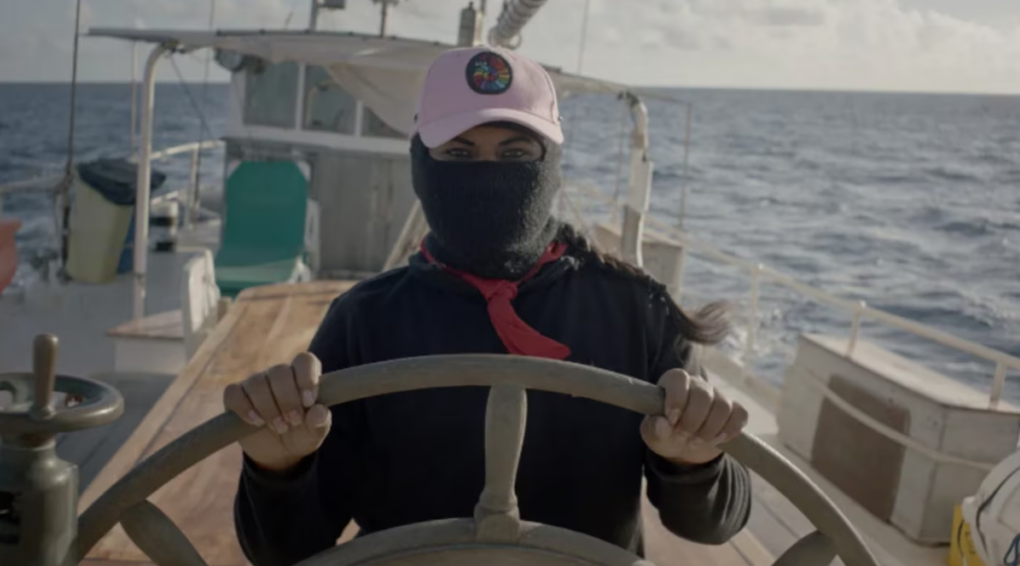
They had to prepare the interview with Ismael “El Mayo” Zambada—something only Julio Scherer had managed—when the phone rang. On one side of the receiver was journalist Diego Enrique Osorno. On the other, a liaison from the Zapatista Army of National Liberation (EZLN) with a proposal: to cross the Atlantic Ocean on a sailboat to spread the word about the indigenous struggle taking place in Chiapas. There was little to think about, but it was necessary to clarify:
“I’m in poor physical condition, and to top it all off, I don’t know how to swim,” Osorno said.
“Don’t worry,” they responded, “some of the Zapatista envoys have never even seen the ocean. (…) We’ll go on La Montaña.”
There are several symbols in La Montaña. One of them was to launch into Europe, the old continent and land of the conquistadors who arrived in America 500 years ago, but now in the opposite direction so that the protagonists of the Indigenous resistance would be the ones to bring the news and make their voices heard throughout the world. Another symbolism was described by Enrique Florescano in his book Memora Indígena:
“In the heart of the population, they erected a replica of the first mountain that emerged from the primordial waters on the inaugural day of the cosmos. This hill, which the Maya called Yax Hal Witz, the First True Mountain, and the Nahua called Tonacatépetl, the Hill of Maintenance, was the symbol of the emergence of the earth and its creation with the three levels of the cosmos: the underworld, the earth’s surface, and the sky (…) The first True Mountain was also a symbol of fertility: the earth that held within it the nourishing seeds and fertilizing waters that nourished the first human beings.”
This is how The (Primal) Mountain sailed across the Atlantic in the midst of the COVID-19 pandemic: with a witness (a journalist) and a group of EZLN representatives to update the chronicle of the armed movement that erupted on January 1st, 1994. It also served as a reminder that the Zapatista movement remains one of the current government’s biggest headaches. The searching mothers and journalists are two others.
“They know this deep down. Zapatismo reminds them of what the governments in power are betraying,” says Diego Enrique Osorno, recalling his journey across the Atlantic. Without knowing how to swim.
“El Mayo Zambada was sitting in front of me, and I began to tell him who I was. The former leader of the Sinaloa Cartel (arrested on July 25th, 2024) was desperate because a guy was telling him about his life. I was taking up his time—they had given me 30 minutes for the interview—and making him very anxious. It wasn’t until I mentioned Julio Scherer that he became interested, stood up, and settled in. “It’s a shame we can’t revive him,” he told me. Then we talked for three hours,” Osorno recalls during the presentation of his book En la Montaña (On the Mountain).
The interview with El Mayo Zambada took place in the middle of the pandemic (2021) and also required going to a mountain, but this time in Sinaloa, the heart of the world’s largest criminal organization and today the epicenter of a civil war that has lasted almost seven months and claimed the lives of more than 900 people. They say Los Chapitos betrayed Zambada, and La Mayiza responded with “lead.”
It’s a pandemic, and Osorno is considering whether it’s necessary to wear a face mask to his meeting with El Mayo Zambada—the precaution is no small matter; more than 800,000 people have died from COVID-19, according to a report by the Independent Commission of Investigation. The kingpin appears, and the image is not unlike the photograph with Julio Scherer: “Jeans, polo shirt, ripped belt, boots, and a hat.” Especially a hat, like those left by Los Chapitos hitmen on the bodies scattered in Culiacán.
El Mayo Zambada and Diego Enrique Osorno talk about Julio Scherer, Felipe Calderón’s “war on drugs,” norteño music, narcocorridos in honor of Señor del Sombrero (The Lord of the Hat) and El Quinto Mes (The Fifth Month); they also talk about peace. “Peace isn’t said, it’s made. Peace arises from loyalty,” the drug lord declares, unaware that three years later, an alleged betrayal by Los Chapitos will land him a direct ticket to a US prison.
“We do journalism with our asses in our hands,” said Javier Valdez. “No, Javier, with our hands on our asses,” corrected Ismael Bojórquez, Osorno writes in his book.
Because yes, it’s also a book to remember and demand justice for Javier Valdez, silenced by the Sinaloa Cartel—still under the command of “Mayo” Zambada—on a “damned” afternoon in May 2017. In the Mountains is a reminder of everything that bothers the government. What society and journalists must not forget: it’s a book to avoid falling into the “pornography of terror and the spectacle of tragedy.” A book to remind us that “being realistic in these times is being pessimistic.”
Original article by Ernesto Jiménez, Infobae, April 1st, 2025.
Translated by Schools for Chiapas.